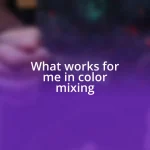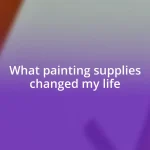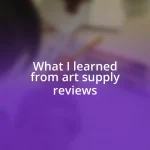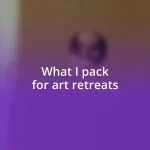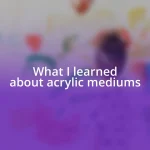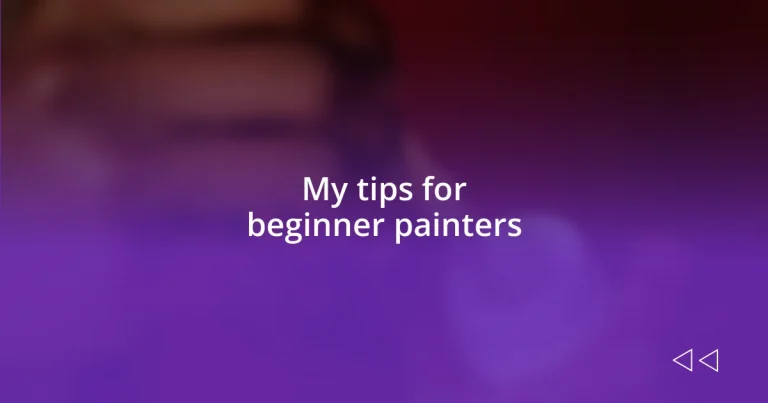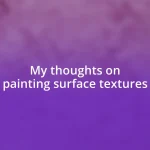Key takeaways:
- Choosing quality materials, including brushes and canvases, significantly enhances the painting experience and outcomes for beginners.
- Understanding color theory, such as warm vs. cool colors and complementary color combinations, is essential for creating impactful artwork.
- Practicing techniques like brush control, layering, and embracing spontaneity in different mediums fosters creativity and artistic growth.
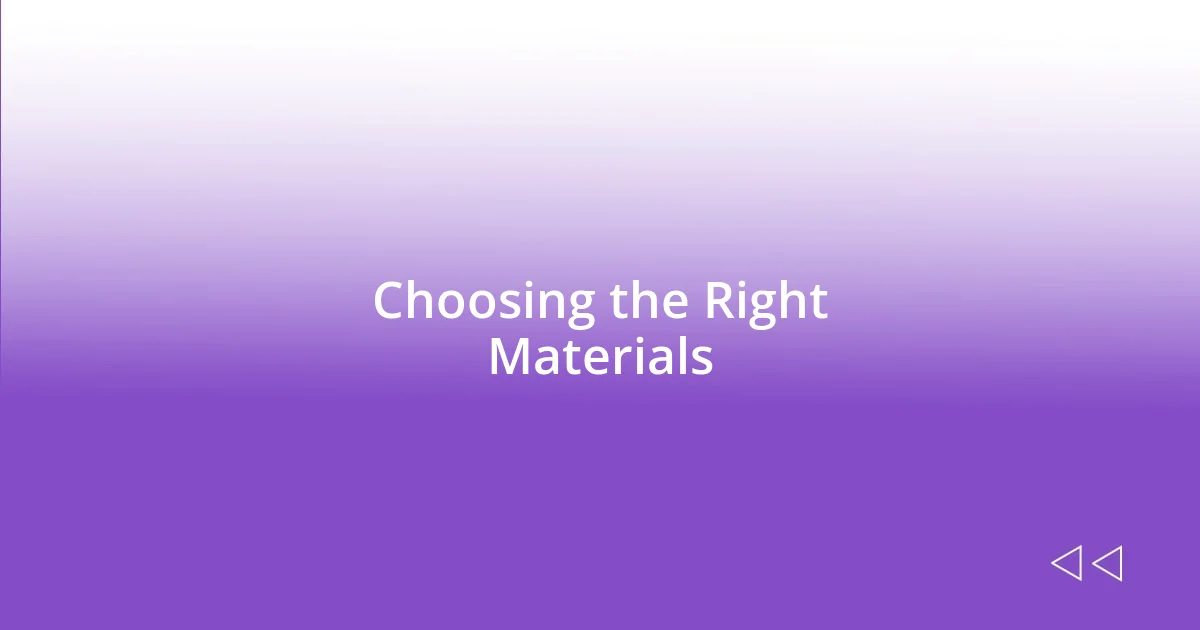
Choosing the Right Materials
Choosing the right materials can profoundly impact your painting experience, especially as a beginner. I remember walking into an art supply store for the first time, feeling overwhelmed by the sheer amount of choices. I settled on a basic set of acrylics. Looking back, I realize that simplicity was key; fewer options helped me focus on learning rather than getting lost in the details.
When it comes to brushes, don’t underestimate their importance. I once grabbed a cheap set without really thinking about it, only to realize they didn’t hold paint well. Using quality brushes can make a significant difference in how the paint glides across the canvas. Have you ever felt frustrated mid-painting? I certainly have, and it’s usually when I’m not equipped properly.
Selecting the right canvas is crucial, too. Whether you choose stretched canvases, canvas boards, or paper, consider how each surface interacts with your chosen medium. My first paintings on cheap paper left me disappointed, as the colors didn’t saturate the way I’d hoped. By investing in a few decent canvases, I found my work transforming, and the joy of painting became more fulfilling. What materials have you found to be essential in your artistic journey?
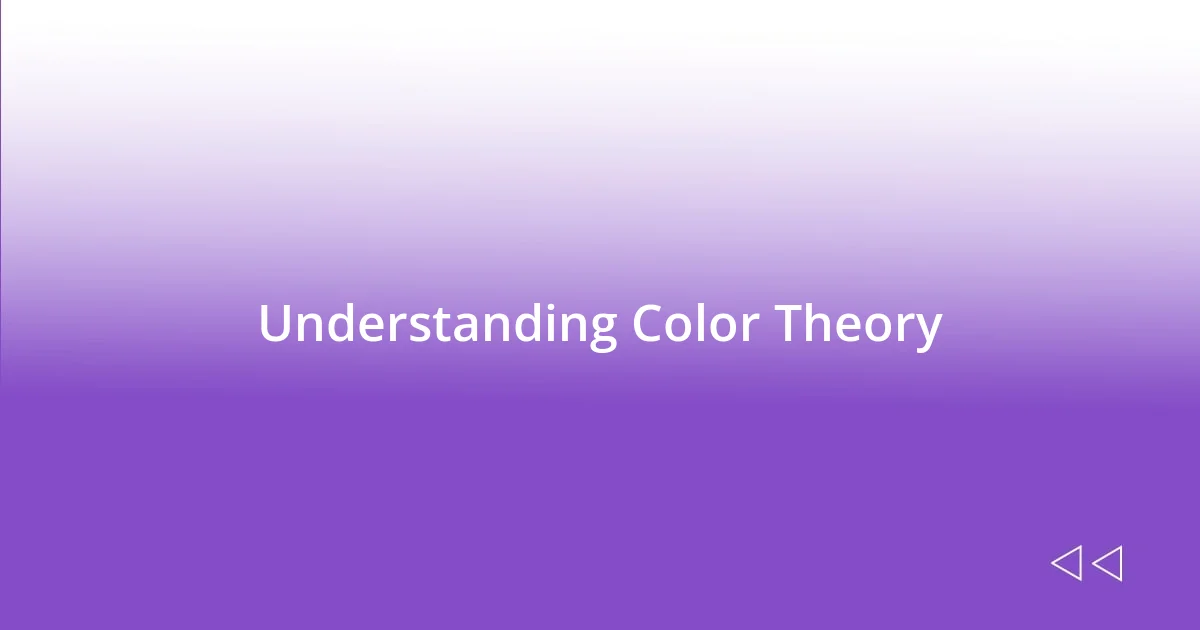
Understanding Color Theory
Understanding color theory is essential for any beginner painter, as it lays the groundwork for creating harmonious and impactful artwork. I still vividly remember the moment I grasped the concept of the color wheel. It was like finding a treasure map; suddenly, I could see the relationships between colors and how they interact. Knowing primary colors—red, blue, and yellow—and how to mix them to create secondary colors expanded my palette and my creativity.
Here are some fundamental aspects of color theory to consider:
- Warm vs. Cool Colors: Warm colors (like reds and yellows) can evoke feelings of energy or excitement, while cool colors (like blues and greens) typically create calmness or tranquility.
- Complementary Colors: Colors that are opposite each other on the color wheel, such as blue and orange, can make each other pop, creating dynamic contrast in your work.
- Analogous Colors: These are groups of colors that are next to each other on the wheel—think blue, blue-green, and green—creating a pleasing and cohesive look.
- Values and Shades: Understanding how to mix colors with white (to create tints) and black (to create shades) helps in developing depth and dimension in your paintings.
When I experimented with complementary colors in my early works, I had this exhilarating ‘aha’ moment. The vibrancy and contrast brought my landscapes to life, igniting a newfound excitement in my painting practice. Being mindful of these theories can transform not just how you paint, but how you express your feelings through art. What colors speak to your emotions?
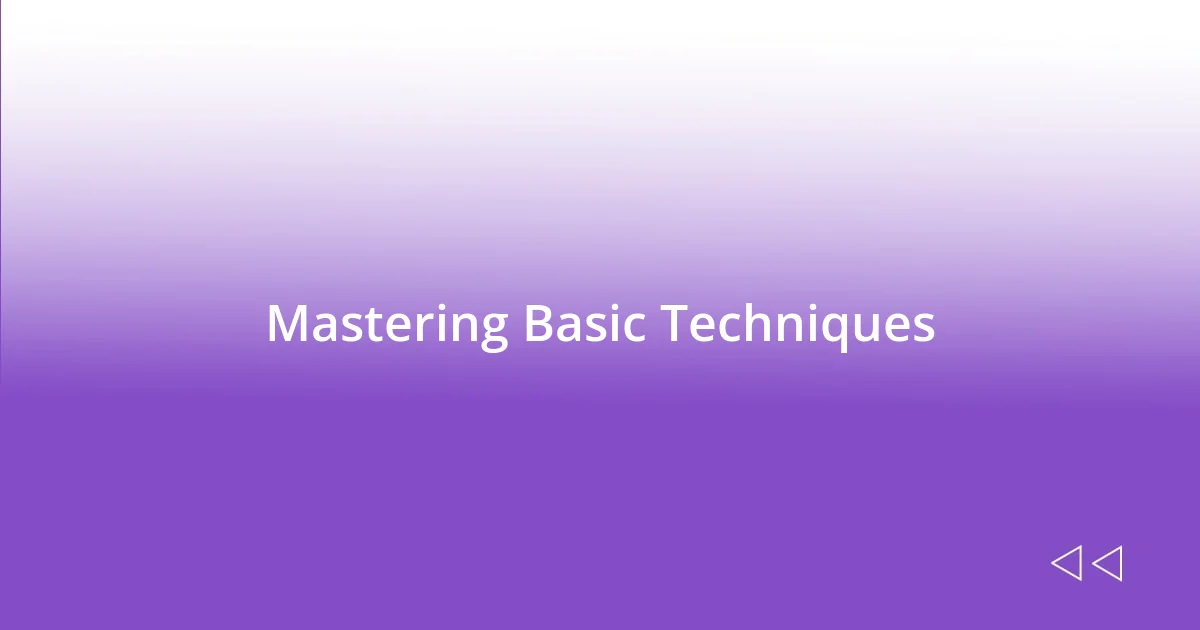
Mastering Basic Techniques
Mastering the basic techniques is essential for any beginner painter, and I’ve learned that practice is truly the key to growth. I remember my early days, where I often felt clumsy and unsure, especially when trying to apply different brush strokes. Through persistent effort, I discovered the beauty of layering. It’s fascinating how adding thin layers of paint can create depth and texture that flat paint simply can’t achieve.
One technique that shifted my perspective was the importance of the wash. Using a wash can set the mood for the entire piece; it’s like creating a beautiful backdrop before diving into details. I still recall my first wash—it was a simple blue sky behind a landscape, but the way it unified the scene felt magical. Have you found a technique that dramatically improved your work?
Additionally, learning to control the pressure and angle of the brush can dramatically influence your results. I had a habit of pressing too hard, leading to harsh lines and an uneven application. Once I adjusted my grip and learned to play with varying pressure, my line quality improved significantly. These small adjustments can yield remarkable changes over time, transforming your art from basic to something that truly resonates.
| Technique | Description |
|---|---|
| Layering | Building multiple thin layers for depth and complexity. |
| Wash | A diluted paint layer used as a base or background to set the mood. |
| Pressure Control | Varying the pressure on the brush to change line quality and paint application. |
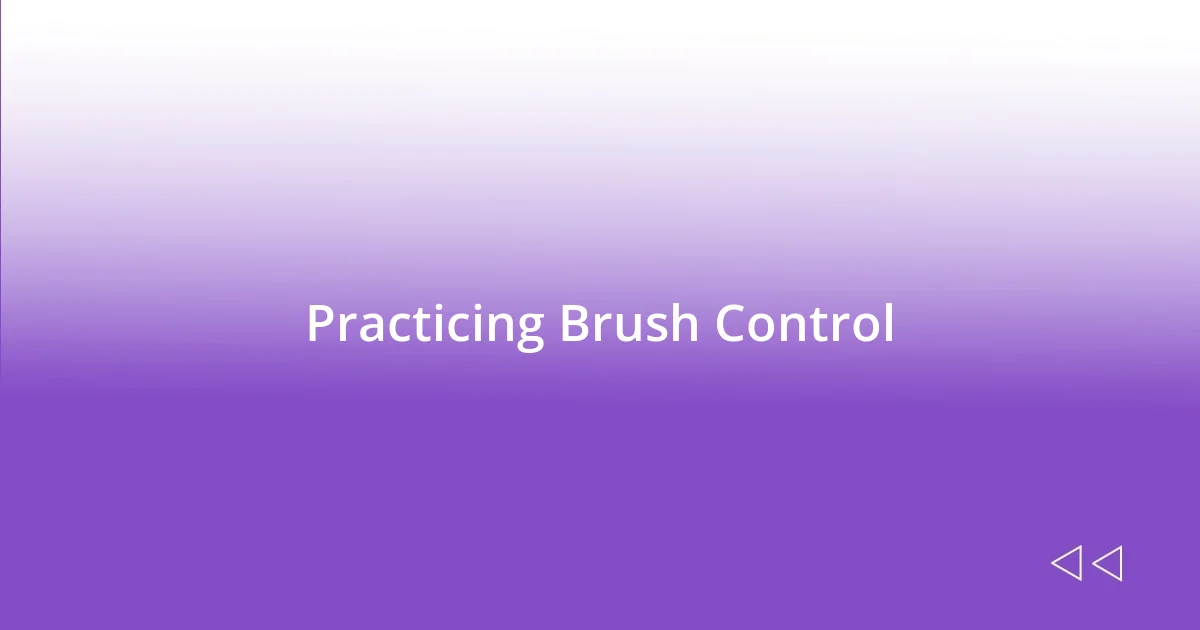
Practicing Brush Control
Practicing brush control is something I can’t stress enough for beginners. When I first began painting, I struggled with how much pressure to apply. I remember the day I decided to practice delicate strokes instead of my usual heavy-handed approach. It was surprisingly liberating; I found that softer strokes allowed me to capture light and texture in ways I hadn’t thought possible. Have you ever felt a sense of freedom when you allowed your brush to lightly dance across the canvas?
One exercise that helped me tremendously was painting straight lines and curves of varying widths. I soaked up the frustration of my shaky hands, but over time, each stroke became more deliberate. I stayed flexible; sometimes, the imperfections—a slight wobble or uneven width—felt like they added character to my piece. In a way, those little flaws became something I cherished. How do you view imperfections in your work—do they worry you or make you feel more connected to it?
As I practiced, I also experimented with different brushes. I learned that a smaller brush demands finesse, while a larger one can deliver sweeping gestures. I remember switching from a synthetic round brush to a flat brush and marvelling at how it completely transformed my dipped-in-the-paint method into something more fluid. This exploration helped me realize that mastery comes with experimentation and play. How might switching your tools change your painting experience?
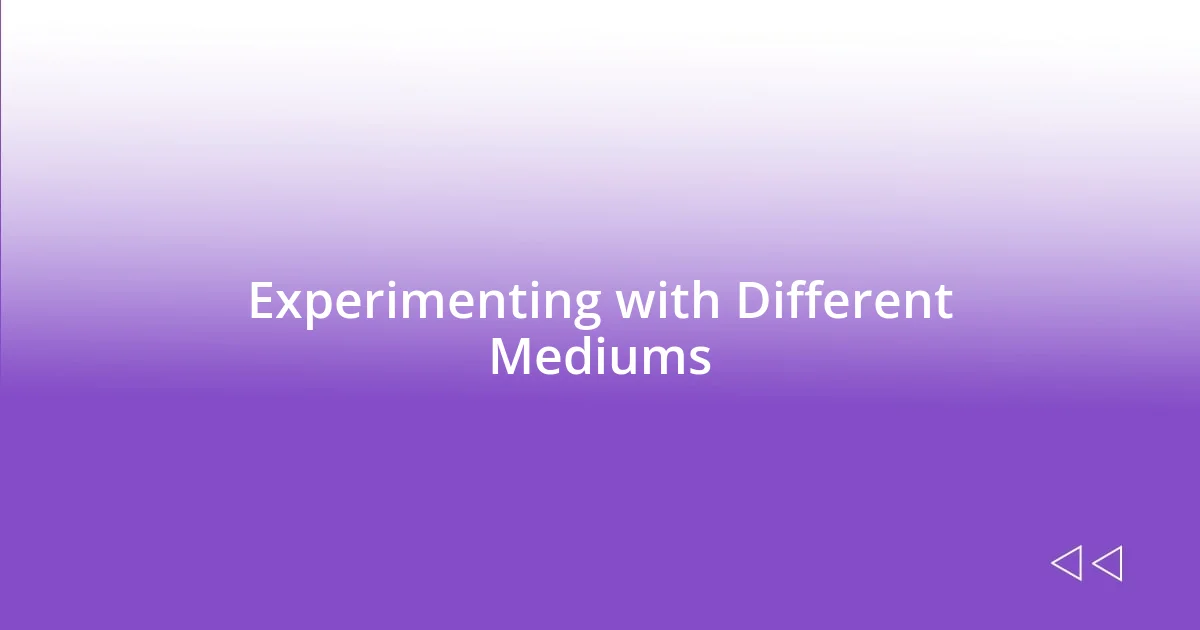
Experimenting with Different Mediums
When I first dipped my toes into various painting mediums, it felt like unlocking a treasure chest of possibilities. I vividly recall trying watercolor for the first time; the way it flowed and blended on the paper was enchanting. I felt a rush of excitement and fear all at once—would I control it, or would it take over my canvas? The unpredictable nature of watercolor taught me to embrace spontaneity. In what ways do you think stepping outside your comfort zone can enhance your creativity?
After exploring watercolors, I couldn’t resist the charm of oil paints. The richness of each color, combined with the slow drying time, felt luxurious. I remember spending hours layering oils, relishing the opportunity to rework sections without panic. This renewable approach to painting made mistakes feel less daunting and even, dare I say, part of the artistic process. Isn’t it intriguing how different mediums can evoke distinct emotional responses while we create?
Even within acrylics, I discovered that experimenting with varying viscosities opened up a new world. One afternoon, I mixed heavy body acrylics with fluid mediums to create a dynamic texture. Watching the paint interact was mesmerizing, akin to crafting a recipe where each ingredient brought its unique flavor. I felt a wave of joy as I unleashed my creativity—what textures have transformed your painting experience? Exploring different mediums isn’t just about the paint; it’s a journey of self-discovery, revealing the many facets of our artistic voices.
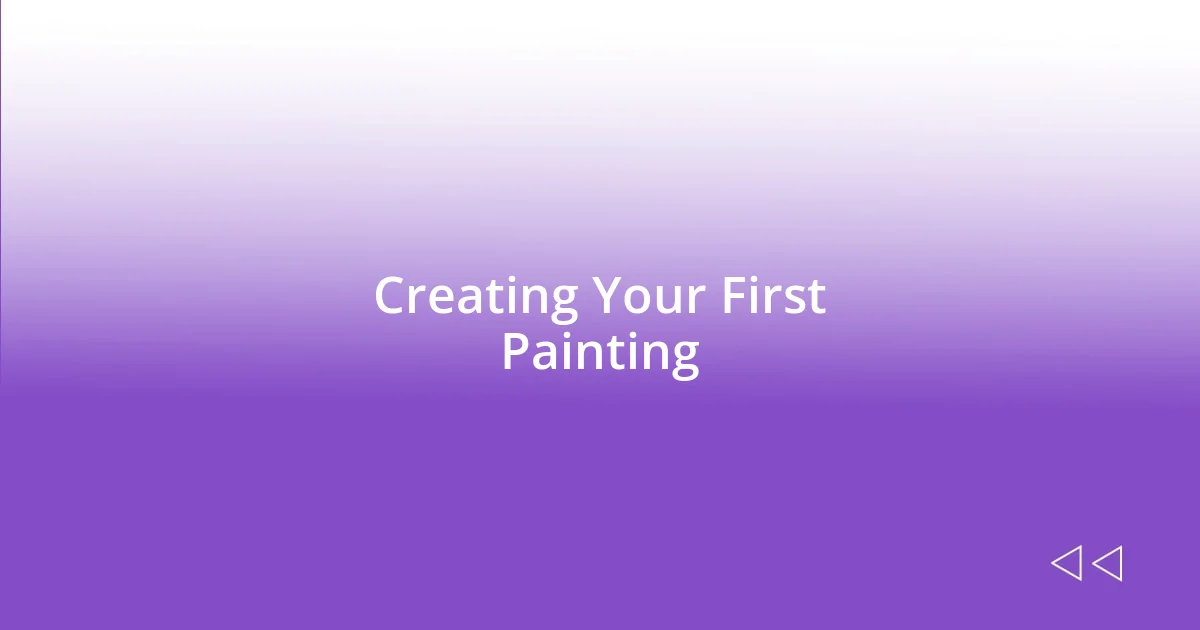
Creating Your First Painting
Creating your first painting is both exhilarating and intimidating. I remember standing in front of my blank canvas, heart racing with anticipation. That first stroke felt monumental—like a declaration of my intent. Have you ever felt that mixture of excitement and apprehension as you faced a fresh blank slate? It’s a thrilling moment when your brush transforms the emptiness into something uniquely yours.
I discovered quickly that planning every detail can sometimes stifle creativity. On my first attempt, I sketched a detailed outline of what I wanted, but as I painted, I found my mind drifting towards spontaneous shapes and colors that were far more appealing. Letting go of my initial plan invited a sense of freedom that truly energized my process. I wonder, have you ever found magic in those unexpected turns while creating?
One piece of advice I hold dear is to embrace the process rather than fixating on the outcome. My first painting ended up looking nothing like what I envisioned, yet the joy of blending colors and finding my rhythm made every moment worthwhile. I even hung that quirky piece in my living room, reminding me of the journey rather than a specific destination. What would it feel like to create without the pressure of perfection guiding your hand?

Seeking Feedback and Improvement
Seeking feedback can be a transformative experience for beginners. I still remember the first time I shared my artwork with a local art group. Their insights ranged from encouraging to constructive, and while my heart raced with vulnerability, each suggestion felt like a little piece of gold, guiding me to improve. Have you ever wondered how outside perspectives can breathe new life into your work?
Finding a mentor or an artist community can be invaluable as you navigate your painting journey. I sought out a seasoned artist who generously shared techniques and suggested ways to enhance my color palette. The way she explained color theory with such passion sparked my curiosity on deeper levels. Reflecting on your experiences, how has learning from others shaped your artistic evolution?
Lastly, don’t shy away from critiques; they are opportunities for growth. I recall receiving feedback that pointed out unnecessary details in a piece I held dear. Initially, I felt a twinge of defensiveness, but later, I realized that simplification could amplify the message. How can criticism help you see your work from new angles? Embracing feedback, both good and bad, can ultimately lead to breakthroughs in your artistic style.
